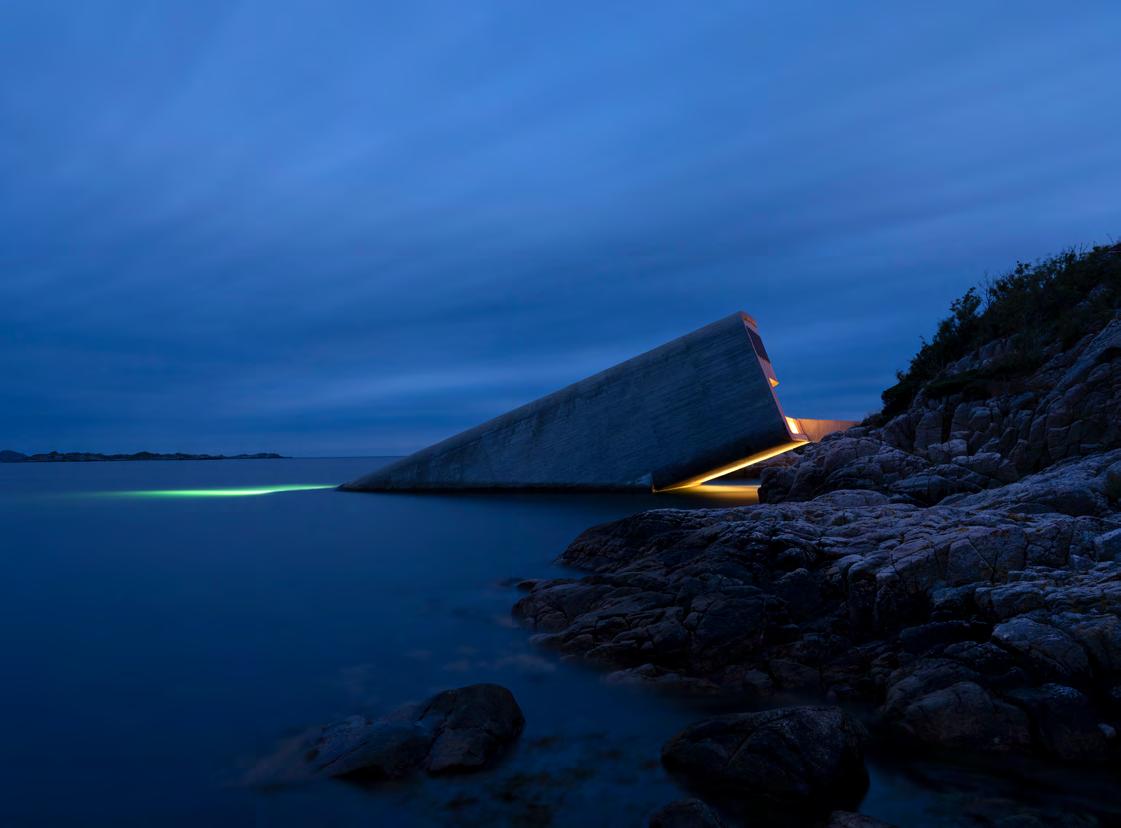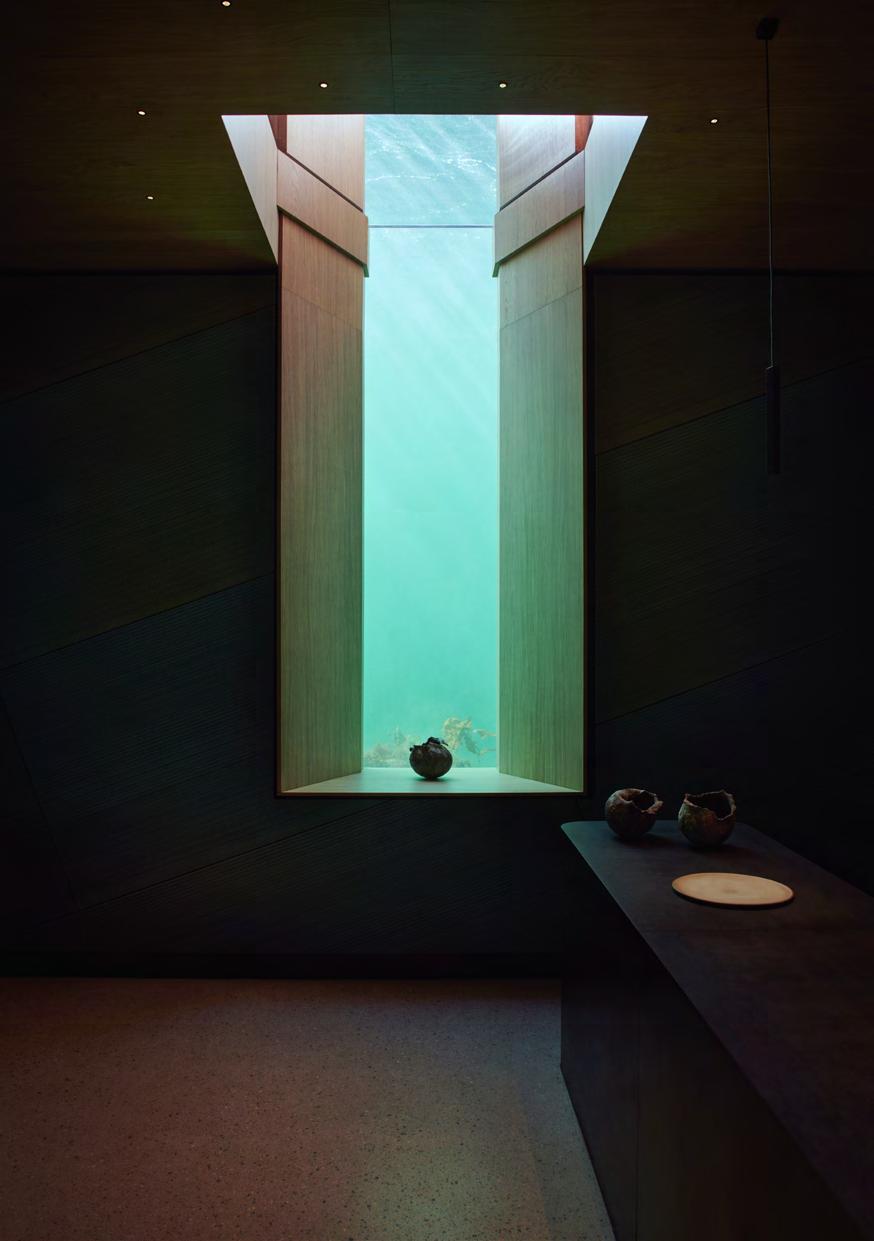
7 minute read
The Technology Issue Autumn '22
Building a Mystery
A deep dive into Chef Nicolai Ellitsgaard and Under Restaurant
Written by Cary Wong
The underwater location feels more like a secret high-tech laboratory or a lair of a Bond villain. And if you guess the former, you would be half correct.
This is Under, a restaurant and a science project of sorts in Lindesnes, Norway, located exactly 5.5 meters under sea level. With a dining area of 495 square meters and a capacity of 40, it is the biggest underwater restaurant in the world.

Chef Nicolai Ellitsgaard
Photos provided by Under Ivar Kvaal
As an architectural marvel, it was designed by the Norwegian architectural office called Snøhetta and took only 14 months to build. First, a big hollow concrete block was constructed. Then it was put in the ocean and dragged to the current location. To avoid floating, it was filled with water to make it sink down.
During the final steps, 14 different spots of the seabed were locked-in. And after emptying all the water, everything else inside was constructed—important details like stairs and elevators, among others.
The restaurant’s exterior features some peculiar things: seaweeds growing on the concrete. Snails, limpets, and blue mussels have also started to attach themselves to the outside of the restaurant and spawn organically. All these things live and die in a very natural rhythm.

Under Restaurant Lindesnes, Norway
Photos provided by Under Ivar Kvaal
The sense of surprise continues from the moment the diners enter the restaurant to the menu. As the guests step foot in Under, the restaurant’s six-hour-long soundtrack is played in the background. They are then led to sit on low couches that partly obscure the full view. The dramatic window that overlooks the ocean does not reveal itself
until the guests are further along the dining experience. All of this happens while the guests are completely blind about the food—because the restaurant does not publish its menu online.
“I think it is important when you go out and dine… that you relax and not think about what's coming or what's not coming. You just have to enjoy the moment,” Chef Nicolai Ellitsgaard says.
The guests will be served what the team thinks is the best on that day. Not only is that an artistic statement, but it is also a practical consideration. The remote location is a one-and-a-half-hour drive to the closest city. If an ingredient is not of high enough quality, the team has to be able to replace it with something better that is available.
To add to (or subtract from, depending on one’s view) the riddle, this town of 200 people is a healthy 5-hour drive south of Oslo, the Norwegian capital.
In this setting, Danish chef Nicolai Ellitsgaard is hard at work in more innovative ways than only food. And just so we are clear, there is no romantic backstory here.
“I was tired of school, and I needed something to do, and then my teacher said that maybe you should try to become a chef,” he says.

Photos provided by Under Ivar Kvaal
In the Danish school system, the students get two weeks in ninth and tenth grades to go and try to learn a particular skill— for example, a plumber or a carpenter. It was under this circumstance that he first stepped foot in a professional kitchen, and after the first week, “I just fell totally in love.”
He did not have high expectations initially. It was just fun for him to cook. One day, the chef at his apprenticeship told him the way he worked was not good enough. That he had to think about what he wanted in life. Chef Ellitsgaard’s response? He wanted to have a Michelin star restaurant in the future. That was the turning point that pushed him to become the best that he could be.
The restaurant concept is strictly about showcasing southern Norway and all its culinary possibilities. So outside ingredients are prohibited. Foraging and locality became the two backbones of the menu, and these restrictions forced him to think differently.
Olive oil, for example, could not be used. To overcome this, he tested wild plants from nearby forests in all their forms—from fresh to preserved to fermented—that are stored in a two-and-a-half-ton fridge container the team
calls “the bunker.” Chef Ellitsgaard discovered that new flavors are often found during the preserving process. And he could replace olive oil with something new that only hints at olive oil without tasting exactly like it.

Photos provided by Under Ivar Kvaal
One may also be surprised to see that in such a marine-focused environment, proteins like lamb make occasional appearances. These animals generally take care of themselves with minimal help from a farmer.
However, most of the star ingredients come from the sea. In addition to common highend regional ingredients, littleunderstood-and-underused-gems and bycatches are also used extensively. One of the things Chef Ellitsgaard discovered was seaweed that tastes like truffles. It took a long time to assess the ingredient to find out what it was. Eventually, a breakthrough was reached, and it is now a regular feature on the menu.
Bycatch is another elevated item at Under. The name conjures up images of organisms unfit for human consumption, let alone used by a high-end restaurant. In reality, however, it refers to crab or other crustaceans caught in a fish trap.
Take the squat lobster—a small little langoustine that gets caught inside the trap for larger species. The fishermen normally just throw them overboard without using them.


However, Chef Ellitsgaard convinced one fisherman to take care of these crustaceans and then put them to use. As time passed, the species caught on—as some English and French restaurants started to feature them. These exciting developments prove that these items do, in fact, have value.
As for the larger fishes, it is an obligation for those who work with Under to kill and store them using the Japanese Ikejime method that kills the fish instantaneously and drains them of their blood rapidly. When done correctly, it preserves the flavor and texture and allows the flesh to develop a deeper savoriness when aged. It is very interesting when Chef Ellisgaard shows these unconventional techniques to his suppliers - who have done things the same way for fifty years or more - and they see the actual difference in the product quality.

Photos provided by Under Ivar Kvaal
Since the restaurant also functions as a research center for marine life, it takes more than one person to manage everything. Tom Ruffles, Under’s Scientific Adviser, also drives various projects at the restaurant. One such undertaking is investigating the relationship between the amount of fish in the sea and the water salinity/temperature.

Under Restaurant Lindesnes, Norway
Photos provided by Under Ivar Kvaal
“When it rains, the level of salt in the water will fall,” Chef Ellisgaard says—as the amount of fresh river water will rise during that time. The idea is to determine whether that change will impact the yield of what is caught. It is a very interesting study and one that may have a far-reaching impact.
During his personal time, he does not venture far from the ocean. He goes freediving once a month as a hobby but also to find out what next season’s seaweed looks like. During these dives, he also forages for ingredients for his personal use and gets new ideas for the menu.

Under Restaurant Lindesnes, Norway
Photos provided by Under Ivar Kvaal
Additionally, he has recently become the father of a new child, which has become a priority in his life.
With a busy personal and professional life, there is no shortage of mysteries for Chef Ellitsgaard to solve!
@ellitsgaard_under
@Underlindesnes

Healthy Eating Tasteful, Playful, & Beautiful
Farm House Lab











